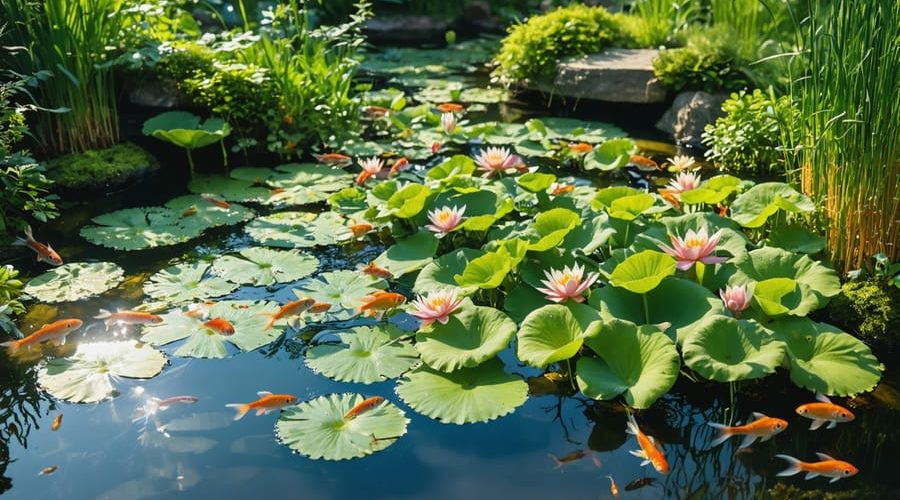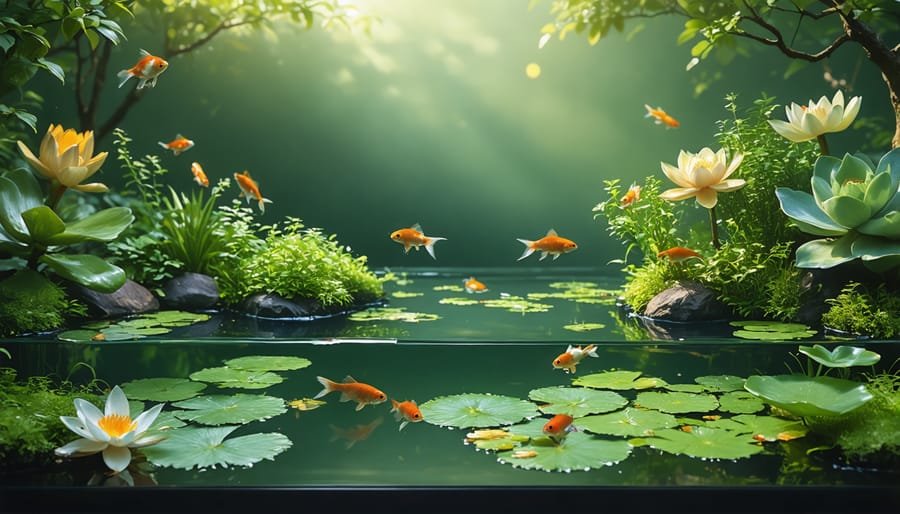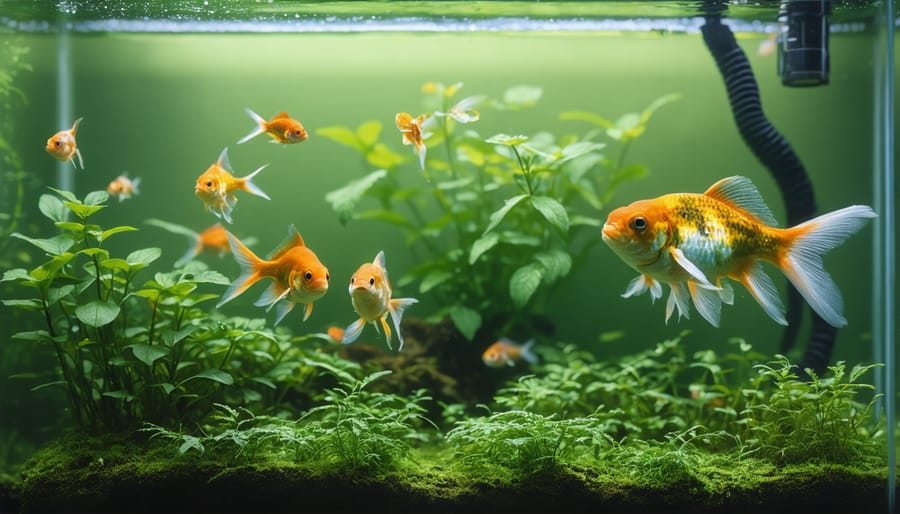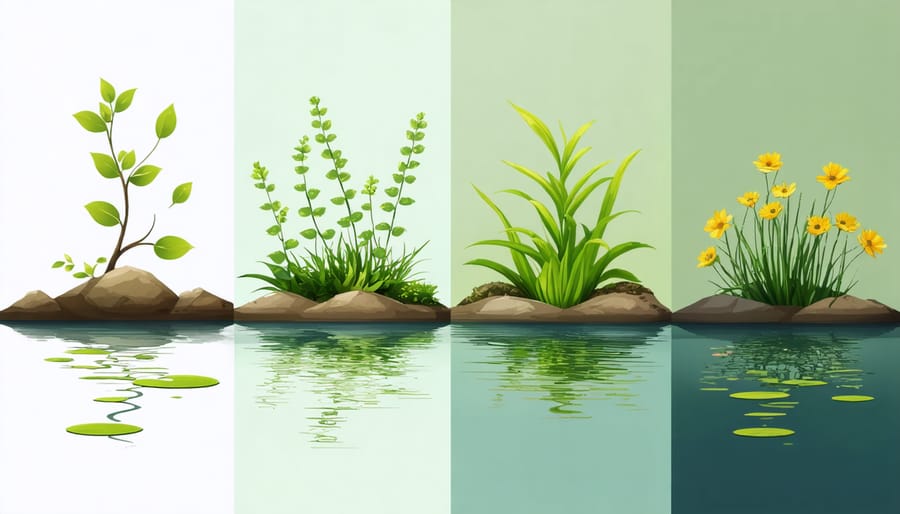
Perfect Plants That Make Your Goldfish Pond Thrive
Transform your goldfish pond into a thriving plant and fish ecosystem by strategically combining floating, submerged, and marginal plants. Water lilies provide essential shade while oxygenating plants like Anacharis and Hornwort maintain crystal-clear water quality. Hardy rushes and iris varieties create natural filtration along pond edges, protecting goldfish from predators while absorbing excess nutrients. These aquatic plants work in harmony with goldfish, offering shelter, natural food sources, and improved water clarity – all while creating a stunning, low-maintenance water garden that naturally balances itself throughout the seasons.
Choose plants that serve multiple purposes: surface coverage for temperature control, root systems for spawning areas, and vertical elements for visual interest. Strategic placement of these plant varieties creates distinct zones within your pond, each supporting different aspects of goldfish health and pond ecology. Start with 60% plant coverage using a mix of species to establish a self-sustaining ecosystem that requires minimal intervention while maximizing both functionality and beauty.

Essential Plants for Goldfish Ponds
Oxygenating Plants
Oxygenating plants are essential powerhouse plants for ponds, working tirelessly beneath the surface to keep your goldfish healthy and happy. These underwater warriors produce oxygen during daylight hours and help maintain crystal-clear water by competing with algae for nutrients.
Some of the best oxygenating plants for goldfish ponds include Hornwort, which grows in flowing bunches and provides excellent hiding spots for fish fry. Anacharis (also known as Elodea) is another fantastic choice, with its bright green stems and leaves that wave gracefully in the water. Water Milfoil is particularly effective at oxygenating deeper areas of your pond, while American Waterweed creates dense underwater forests that goldfish love to explore.
These plants don’t just produce oxygen – they’re natural filtration systems too! They absorb excess nutrients from fish waste and fallen leaves, helping to prevent algae blooms. Most oxygenating plants are easy to maintain; simply trim them back when they become too dense and remove any dying leaves to keep the water clean.
For best results, aim to cover about 50-60% of your pond’s surface with a mix of these plants. Plant them in weighted bunches or pots filled with aquatic soil, placing them at various depths. While goldfish might occasionally nibble on these plants, most species are tough enough to withstand some fish attention while continuing their vital work of keeping your pond ecosystem balanced and healthy.
Remember to introduce these plants gradually and monitor your water quality as the system establishes itself. Your goldfish will thank you with more vibrant colors and active behavior!

Floating Plants
Floating plants are essential additions to any goldfish pond, creating a natural, balanced ecosystem while providing vital benefits for your aquatic pets. These surface-dwelling plants help reduce algae growth by limiting sunlight penetration and offering shelter for goldfish from predatory birds and harsh weather.
Water lilies are perhaps the most popular floating plants, with their stunning blooms and broad leaves that provide excellent shade coverage. They come in various colors and sizes, making them perfect for both small and large ponds. For optimal growth, plant them in underwater containers filled with aquatic soil, positioning them so the leaves can reach the surface.
Duckweed, while tiny, spreads rapidly across the water’s surface and serves as a natural water purifier. It also becomes a tasty snack for goldfish, though you’ll want to monitor its growth to prevent overcrowding. Water lettuce is another excellent choice, featuring rosettes of velvety leaves that create attractive floating gardens while helping to maintain water quality.
Floating heart plants offer similar benefits to water lilies but on a smaller scale, making them ideal for modest-sized ponds. Their heart-shaped leaves provide shade while their delicate yellow flowers add visual interest throughout the growing season.
When introducing floating plants, start with a coverage of about 50-60% of your pond’s surface area. This balance allows enough light penetration for submerged plants while maintaining adequate shade and protection for your goldfish. Remember to thin out fast-growing species periodically to maintain this optimal coverage.
Marginal Plants
Marginal plants are essential elements in creating a thriving pond edge and provide numerous benefits for your goldfish habitat. These plants grow in shallow water, typically in depths of 0-6 inches, and help stabilize the pond’s borders while creating natural transitions between water and land.
Popular marginal plants for goldfish ponds include Purple Loosestrife, Japanese Rush, and Yellow Flag Iris. These plants not only look beautiful but also provide shelter for goldfish from predators and help reduce erosion around your pond’s edges. Marsh Marigolds add splashes of bright yellow color in spring, while Sweet Flag offers architectural interest with its sword-like leaves.
When planting marginals, use aquatic baskets filled with heavy clay-based aquatic soil. Position them on shelves or ledges around the pond’s perimeter, ensuring they sit at their preferred water depth. Most marginals will thrive when their crown (where the stems meet the roots) is just below the water surface.
These plants play a crucial role in natural filtration, absorbing excess nutrients from fish waste and helping maintain water clarity. They also provide spawning areas for goldfish and create shade that helps regulate water temperature during hot summer months.
For the best results, space your marginal plants about 12-18 inches apart to allow room for growth. Regular maintenance includes removing dead foliage and dividing overcrowded plants every 2-3 years. In winter, most marginals can remain in place, as they’ll naturally die back and regenerate in spring.
Remember to choose a variety of plants that bloom at different times to ensure year-round interest and continuous benefits for your goldfish pond ecosystem.
Creating the Perfect Plant Balance
Creating the perfect balance of plants in your goldfish pond isn’t just about aesthetics – it’s crucial for maintaining a healthy ecosystem. The general rule of thumb is to cover 50-60% of your pond’s surface area with plants, leaving plenty of open water for your goldfish to swim and explore.
Start by choosing the right perfect pond plant substrate and distributing your plants in layers. Aim for a mix of different plant types: 40% submerged plants, 30% floating plants, 20% marginal plants, and 10% deep-water plants. This combination provides optimal filtration, oxygenation, and shelter for your goldfish.
When placing your plants, think like a landscape designer. Position taller marginal plants at the back of the pond, creating a natural backdrop. Place medium-height plants along the sides, and let floating plants drift freely in the middle sections. Remember to leave clear swimming channels for your goldfish to navigate through.
For smaller ponds (under 500 gallons), stick to compact varieties and reduce the number of plants accordingly. Larger ponds can accommodate more diverse plant collections, but always maintain the recommended coverage ratio.
Keep an eye on plant growth throughout the seasons. In spring and summer, you might need to thin out rapidly growing species to maintain the balance. During fall, remove dying foliage to prevent excess organic matter from decomposing in the water.
Group plants with similar care requirements together to make maintenance easier. Place heavy feeders near each other so you can target fertilization effectively. This thoughtful arrangement not only looks beautiful but also creates distinct zones that benefit both plants and fish.
Remember that achieving the perfect balance might take some trial and error. Start with a few essential plants and gradually add more as you observe how your goldfish interact with them. This patient approach helps you create a naturally balanced ecosystem that’s both beautiful and functional.
Plant Protection Strategies
While goldfish are delightful pond inhabitants, their natural foraging behavior can sometimes wreak havoc on your aquatic plants. Fortunately, there are several effective strategies to protect your plants while still allowing your fish to exhibit their natural behaviors.
Start by using pot protection techniques. Place larger rocks or decorative stones on top of the soil in planted containers to prevent goldfish from digging up roots and disturbing the substrate. Mesh baskets or pond plant fabric can also be wrapped around pot tops while still allowing plants to grow through.
Strategic placement is key to plant survival. Position more delicate plants on higher shelves or in raised areas where goldfish are less likely to reach them. Reserve lower depths for hardier plants that can withstand some fish attention. Creating designated feeding areas away from planted zones can also help redirect fish activity.
For floating plants, consider using floating rings or barriers to section off certain areas. This allows plants like water lilies to establish themselves without being constantly nudged by curious fish. You can also create plant islands using mesh platforms that keep roots safely above the fish’s reach while allowing them to grow naturally into the water.
Don’t forget about planting density – grouping plants together creates natural barriers and safe spaces for smaller or more delicate species. This mimics natural environments while providing better protection than isolated plants. Start with established plants rather than young ones, as mature specimens are more resilient to fish disturbance and have stronger root systems.
Finally, ensure your goldfish are well-fed with a balanced diet to reduce their urge to forage aggressively among the plants. This simple step can significantly decrease plant damage while maintaining a healthy ecosystem.
Seasonal Plant Care
Proper seasonal care ensures your goldfish pond plants thrive year-round. In spring, trim away any dead foliage and divide overgrown plants before new growth begins. This is also the perfect time to add fertilizer tablets to your planting baskets and introduce new plants to your pond.
During summer, maintain regular pruning schedules to prevent plants from overtaking the pond. Remove yellowing leaves and deadhead flowering plants to encourage continuous blooming. Watch water levels carefully, as summer heat increases evaporation and may affect shallow-rooted plants.
Fall preparation is crucial for plant survival. Begin reducing fertilization gradually and remove dying foliage before it can decay in the water. For tropical species, plan to bring them indoors before the first frost.
In winter, protect hardy water plants by moving them to deeper water where they won’t freeze solid. Consider using pond netting to prevent fallen leaves from decomposing in the water. Some floating plants can be stored in indoor aquariums until spring, while marginal plants might need mulching for extra protection during severe cold spells.

Creating a thriving goldfish pond with the right mix of plants is a rewarding endeavor that enhances both the beauty of your outdoor space and the health of your aquatic pets. By incorporating a variety of floating, submerged, and marginal plants, you’ll create a balanced ecosystem that your goldfish will love. Start small, experiment with different plant combinations, and watch as your pond transforms into a stunning water garden that provides years of enjoyment for both you and your fish.
